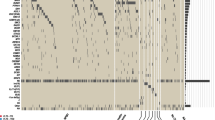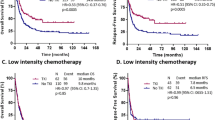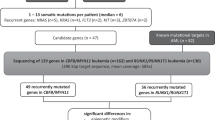Abstract
In core binding factors (CBF) acute myeloid leukemia (AML), the disruption of CBFα/β genes impairs normal hematopoietic differentiation and is supposed to cooperate with additional mutations promoting proliferation. The incidence and the prognosis of receptor tyrosine kinase (RTK) c-Kit and FLT3 mutations and Ras mutations were evaluated in 103 pediatric and adult patients with CBF-AML. c-Kit mutations were present in 17% patients. c-Kit exon 8 mutations were more frequent in inv(16) than in t(8;21) subset (20 versus 6%). Only one patient had FLT3-ITD but FLT3-D835 was as frequent as reported in AML population (7%). Ras mutations were significantly more frequent in inv(16) than in t(8;21) subset (36 versus 8%, P=0.001). RTK mutations were associated with a higher white blood cell count (WBC) (36 versus 21 G/L, P=0.05). FLT3 mutations were significantly associated with a shorter EFS and survival (P<0.0001 and P=0.0002) owing to an excess of early events. c-Kit mutations were associated with a shorter EFS and RFS (P=0.002 and P=0.003) in t(8;21) but not inv(16) patients. As previously observed, Ras mutations did not affect prognosis. Screening for RTK mutations may help to identify patients with a more adverse outcome and thus susceptible to benefit from intensified protocols or RTK inhibitors.
This is a preview of subscription content, access via your institution
Access options
Subscribe to this journal
Receive 12 print issues and online access
$259.00 per year
only $21.58 per issue
Buy this article
- Purchase on Springer Link
- Instant access to full article PDF
Prices may be subject to local taxes which are calculated during checkout


Similar content being viewed by others
References
Bloomfield CD, Lawrence D, Byrd JC, Carroll A, Pettenati MJ, Tantravahi R et al. Frequency of prolonged remission duration after high-dose cytarabine intensification in acute myeloid leukemia varies by cytogenetic subtype. Cancer Res 1998; 58: 4173–4179.
Marcucci G, Caligiuri MA, Bloomfield CD . Molecular and clinical advances in core binding factor primary acute myeloid leukemia: a paradigm for translational research in malignant hematology. Cancer Invest 2000; 18: 768–780.
Byrd JC, Mrozek K, Dodge RK, Carroll AJ, Edwards CG, Arthur DC et al. Pretreatment cytogenetic abnormalities are predictive of induction success, cumulative incidence of relapse, and overall survival in adult patients with de novo acute myeloid leukemia: results from Cancer and Leukemia Group B (CALGB 8461). Blood 2002; 100: 4325–4336.
Nguyen S, Leblanc T, Fenaux P, Witz F, Blaise D, Pigneux A et al. A white blood cell index as the main prognostic factor in t(8;21) acute myeloid leukemia (AML): a survey of 161 cases from the French AML Intergroup. Blood 2002; 99: 3517–3523.
Delaunay J, Vey N, Leblanc T, Fenaux P, Rigal-Huguet F, Witz F et al. Prognosis of inv(16)/t(16;16) acute myeloid leukemia (AML): a survey of 110 cases from the French AML Intergroup. Blood 2003; 102: 462–469.
Schlenk RF, Benner A, Krauter J, Buchner T, Sauerland C, Ehninger G et al. Individual patient data-based meta-analysis of patients aged 16–60 years with core binding factor acute myeloid leukemia: a survey of the German Acute Myeloid Leukemia Intergroup. J Clin Oncol 2004; 22: 3741–3750.
Burnett AK, Wheatley K, Goldstone AH, Stevens RF, Hann IM, Rees JH et al. The value of allogeneic bone marrow transplant in patients with acute myeloid leukaemia at differing risk of relapse: results of the UK MRC AML 10 trial. Br J Haematol 2002; 118: 385–400.
Suciu S, Mandelli F, de Witte T, Zittoun R, Gallo E, Labar B et al. Allogeneic compared with autologous stem cell transplantation in the treatment of patients younger than 46 years with acute myeloid leukemia (AML) in first complete remission (CR1): an intention-to-treat analysis of the EORTC/GIMEMAAML-10 trial. Blood 2003; 102: 1232–1240.
Jourdan E, Boiron JM, Dastugue N, Vey N, Marit G, Rigal-Huguet F et al. Early allogeneic stem-cell transplantation for young adults with acute myeloblastic leukemia in first complete remission: an intent-to-treat long-term analysis of the BGMT experience. J Clin Oncol 2005; 23: 7676–7684.
Kelly LM, Gilliland DG . Genetics of myeloid leukemias. Annu Rev Genomics Hum Genet 2002; 3: 179–198.
Bowen DT, Frew ME, Hills R, Gale RE, Wheatley K, Groves MJ et al. RAS mutation in acute myeloid leukemia is associated with distinct cytogenetic subgroups but does not influence outcome in patients younger than 60 years. Blood 2005; 106: 2113–2119.
Gari M, Goodeve A, Wilson G, Winship P, Langabeer S, Linch D et al. c-kit protooncogene exon 8 in-frame deletion plus insertion mutations in acute myeloid leukaemia. Br J Haematol 1999; 105: 894–900.
Care RS, Valk PJ, Goodeve AC, Abu-Duhier FM, Geertsma-Kleinekoort WM, Wilson GA et al. Incidence and prognosis of c-KIT and FLT3 mutations in core binding factor (CBF) acute myeloid leukaemias. Br J Haematol 2003; 121: 775–777.
Beghini A, Ripamonti CB, Cairoli R, Cazzaniga G, Colapietro P, Elice F et al. KIT activating mutations: incidence in adult and pediatric acute myeloid leukemia, and identification of an internal tandem duplication. Haematologica 2004; 89: 920–925.
Nanri T, Matsuno N, Kawakita T, Suzushima H, Kawano F, Mitsuya H et al. Mutations in the receptor tyrosine kinase pathway are associated with clinical outcome in patients with acute myeloblastic leukemia harboring t(8;21)(q22;q22). Leukemia 2005; 19: 1361–1366.
Wang YY, Zhou GB, Yin T, Chen B, Shi JY, Liang WX et al. AML1-ETO and C-KIT mutation/overexpression in t(8;21) leukemia: implication in stepwise leukemogenesis and response to Gleevec. Proc Natl Acad Sci USA 2005; 102: 1104–1109.
Goemans BF, Zwaan Ch M, Miller M, Zimmermann M, Harlow A, Meshinchi S et al. Mutations in KIT and RAS are frequent events in pediatric core-binding factor acute myeloid leukemia. Leukemia 2005; 19: 1536–1542.
Schnittger S, Kohl TM, Haferlach T, Kern W, Hiddemann W, Spiekermann K et al. KIT-D816 mutations in AML1-ETO positive AML are associated with impaired event-free and overall survival. Blood 2006; 107: 1791–1799.
Shimada A, Taki T, Tabuchi K, Tawa A, Horibe K, Tsuchida M et al. KIT mutations, and not FLT3 internal tandem duplication, are strongly associated with a poor prognosis in pediatric acute myeloid leukemia with t(8;21): a study of the Japanese Childhood AML Cooperative Study Group. Blood 2006; 107: 1806–1809.
Cairoli R, Beghini A, Grillo G, Nadali G, Elice F, Ripamonti CB et al. Prognostic impact of c-KIT mutations in core binding factor leukemias. An Italian retrospective study. Blood 2005, doi:10.1182/blood-2005-1109-3640.
Perel Y, Auvrignon A, Leblanc T, Michel G, Reguerre Y, Vannier JP et al. Treatment of childhood acute myeloblastic leukemia: dose intensification improves outcome and maintenance therapy is of no benefit – multicenter studies of the French LAME (Leucemie Aigue Myeloblastique Enfant) Cooperative Group. Leukemia 2005; 19: 2082–2089.
Castaigne S, Chevret S, Archimbaud E, Fenaux P, Bordessoule D, Tilly H et al. Randomized comparison of double induction and timed-sequential induction to a ‘3+7’ induction in adults with AML: long-term analysis of the Acute Leukemia French Association (ALFA) 9000 study. Blood 2004; 104: 2467–2474.
Boissel N, Cayuela JM, Preudhomme C, Thomas X, Grardel N, Fund X et al. Prognostic significance of FLT3 internal tandem repeat in patients with de novo acute myeloid leukemia treated with reinforced courses of chemotherapy. Leukemia 2002; 16: 1699–1704.
Kiyoi H, Naoe T, Nakano Y, Yokota S, Minami S, Miyawaki S et al. Prognostic implication of FLT3 and N-RAS gene mutations in acute myeloid leukemia. Blood 1999; 93: 3074–3080.
Callens C, Chevret S, Cayuela JM, Cassinat B, Raffoux E, de Botton S et al. Prognostic implication of FLT3 and Ras gene mutations in patients with acute promyelocytic leukemia (APL): a retrospective study from the European APL Group. Leukemia 2005; 19: 1153–1160.
Kottaridis PD, Gale RE, Linch DC . Flt3 mutations and leukaemia. Br J Haematol 2003; 122: 523–538.
Yanada M, Matsuo K, Suzuki T, Kiyoi H, Naoe T . Prognostic significance of FLT3 internal tandem duplication and tyrosine kinase domain mutations for acute myeloid leukemia: a meta-analysis. Leukemia 2005; 19: 1345–1349.
Cairoli R, Beghini A, Morello E, Grillo G, Montillo M, Larizza L et al. Imatinib mesylate in the treatment of core binding factor leukemias with KIT mutations. A report of three cases. Leuk Res 2005; 29: 397–400.
Nanri T, Matsuno N, Kawakita T, Mitsuya H, Asou N . Imatinib mesylate for refractory acute myeloblastic leukemia harboring inv(16) and a C-KIT exon 8 mutation. Leukemia 2005; 19: 1673–1675.
Cammenga J, Horn S, Bergholz U, Sommer G, Besmer P, Fiedler W et al. Extracellular KIT receptor mutants, commonly found in core binding factor AML, are constitutively active and respond to imatinib mesylate. Blood 2005; 106: 3958–3961.
Leroy H, de Botton S, Grardel-Duflos N, Darre S, Leleu X, Roumier C et al. Prognostic value of real-time quantitative PCR (RQ-PCR) in AML with t(8;21). Leukemia 2005; 19: 367–372.
Krauter J, Gorlich K, Ottmann O, Lubbert M, Dohner H, Heit W et al. Prognostic value of minimal residual disease quantification by real-time reverse transcriptase polymerase chain reaction in patients with core binding factor leukemias. J Clin Oncol 2003; 21: 4413–4422.
Buonamici S, Ottaviani E, Testoni N, Montefusco V, Visani G, Bonifazi F et al. Real-time quantitation of minimal residual disease in inv(16)-positive acute myeloid leukemia may indicate risk for clinical relapse and may identify patients in a curable state. Blood 2002; 99: 443–449.
Tobal K, Newton J, Macheta M, Chang J, Morgenstern G, Evans PA et al. Molecular quantitation of minimal residual disease in acute myeloid leukemia with t(8;21) can identify patients in durable remission and predict clinical relapse. Blood 2000; 95: 815–819.
Schnittger S, Weisser M, Schoch C, Hiddemann W, Haferlach T, Kern W . New score predicting for prognosis in PML-RARA+, AML1-ETO+, or CBFBMYH11+ acute myeloid leukemia based on quantification of fusion transcripts. Blood 2003; 102: 2746–2755.
Acknowledgements
This work was supported by the Canceropole Nord-ouest (Axe onco-hématologie) and by The STIC 2005.
Author information
Authors and Affiliations
Consortia
Corresponding author
Rights and permissions
About this article
Cite this article
Boissel, N., Leroy, H., Brethon, B. et al. Incidence and prognostic impact of c-Kit, FLT3, and Ras gene mutations in core binding factor acute myeloid leukemia (CBF-AML). Leukemia 20, 965–970 (2006). https://doi.org/10.1038/sj.leu.2404188
Received:
Revised:
Accepted:
Published:
Issue Date:
DOI: https://doi.org/10.1038/sj.leu.2404188
Keywords
This article is cited by
-
Hypomethylating agent monotherapy in core binding factor acute myeloid leukemia: a French multicentric retrospective study
Annals of Hematology (2024)
-
The dual role of autophagy in acute myeloid leukemia
Journal of Hematology & Oncology (2022)
-
Molecular dissection of a hyper-aggressive CBFB-MYH11/FLT3-ITD–positive acute myeloid leukemia
Journal of Translational Medicine (2022)
-
Whole exome sequencing of pediatric leukemia reveals a novel InDel within FLT-3 gene in AML patient from Mizo tribal population, Northeast India
BMC Genomic Data (2022)
-
Population Pharmacokinetics and Safety of Dasatinib in Chinese Children with Core-Binding Factor Acute Myeloid Leukemia
Clinical Pharmacokinetics (2022)



